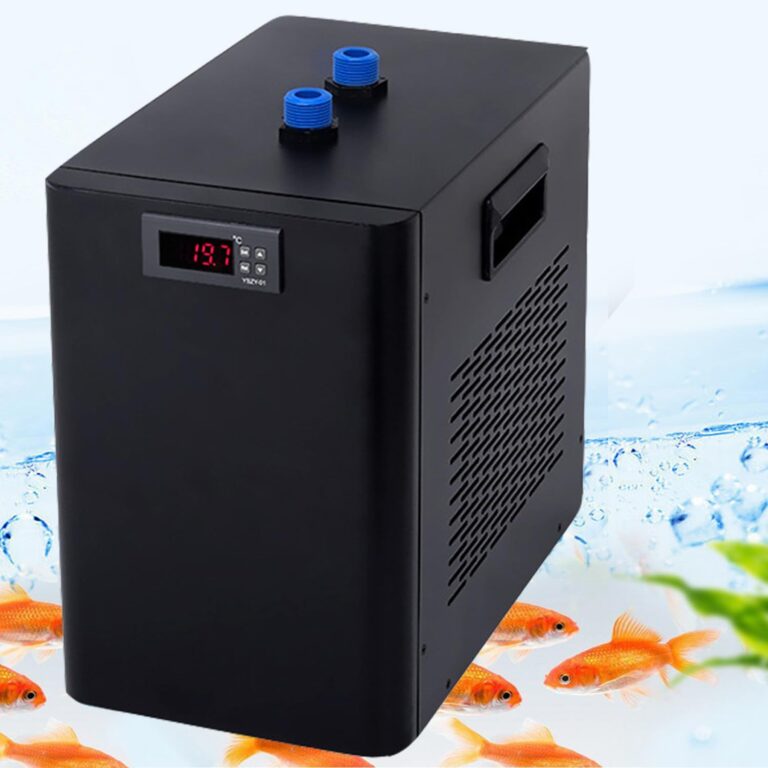Introduction
Fish Tank Water Chiller is a specialized piece of equipment designed to regulate, stabilize, and maintain the ideal water temperature inside an aquarium. Temperature plays a vital role in the health and wellbeing of aquatic organisms — including fish, corals, and invertebrates — because they rely entirely on the surrounding water temperature for metabolic and physiological functions.
Different aquatic species require different temperature ranges to thrive. For example:
- Tropical freshwater fish need temperatures between 24°C to 28°C.
- Saltwater reef tanks typically require 25°C to 27°C.
A sudden or prolonged increase in temperature due to environmental heat, lighting systems, or other equipment can result in:
- Reduced oxygen levels in water
- Increased fish stress and vulnerability to diseases
- Coral bleaching in reef systems
- Algae overgrowth
Thus, a fish tank chiller acts as a safeguard device to remove excess heat and maintain a consistently cool, controlled aquatic environment.
How Does a Fish Tank Water Chiller Work?
A fish tank chiller functions on the principle of heat exchange using a refrigeration cycle — much like an air conditioner or refrigerator.
Here’s a breakdown of the process:
- Water Circulation: Water is drawn from the aquarium via a water pump and passed through the chiller’s heat exchanger.
- Heat Transfer in Evaporator: The water’s heat is absorbed by a refrigerant flowing inside the chiller’s evaporator coil. This lowers the water temperature.
- Compression & Condensation: The now-warmed refrigerant moves to the compressor, where it is compressed and transferred to the condenser. Heat from the refrigerant is released into the surrounding air.
- Coolant Expansion: The refrigerant then passes through an expansion valve, reducing its pressure and temperature.
- Cycle Repeats: The cooled refrigerant returns to the evaporator, and the process continues.
This cycle effectively extracts excess heat from the aquarium water, keeping the temperature stable as per the user’s desired settings.
Components of a Fish Tank Water Chiller
Each part of a chiller system plays a vital role in ensuring efficient and continuous operation:
- Evaporator (Heat Exchanger): The point of direct heat exchange between the aquarium water and refrigerant. It must be corrosion-resistant (preferably titanium in saltwater setups).
- Compressor: The powerhouse of the chiller system. It compresses the refrigerant gas, raising its temperature and pressure to facilitate heat release.
- Condenser: Cools down and condenses the refrigerant gas, converting it back into liquid while expelling heat into the ambient air.
- Expansion Valve: Controls the flow and pressure of refrigerant entering the evaporator, ensuring optimal cooling.
- Water Pump: Circulates aquarium water to and from the chiller unit continuously.
- Digital Temperature Controller: A user-friendly interface allowing temperature adjustment and automatic operation based on pre-set values.
Types of Fish Tank Water Chillers
There are three main types, based on design and application needs:
In-line Chillers
- Installed externally and connected via tubing.
- The aquarium water passes through the chiller and back to the tank.
- Suitable for large or heavily stocked aquariums.
- Offers higher cooling capacity and temperature stability.
Drop-in Chillers
- Features a coil that is directly placed into the aquarium’s sump or filter chamber.
- No plumbing or complex installation needed.
- Perfect for medium-sized setups or when space is limited.
Immersion Chillers
- Uses a cooling coil immersed directly into the fish tank.
- Mainly for small aquariums, breeding tanks, or spot cooling.
- Easy to install but less powerful for larger systems.
Benefits of Using a Fish Tank Water Chiller
- Prevents Temperature Stress
Fish and invertebrates thrive in consistent environments. Temperature fluctuations can cause immune suppression, increased stress hormones, and erratic behavior. Chillers eliminate these risks by ensuring constant, optimal temperatures. - Supports Aquatic Life Health
Stable temperatures result in improved metabolism, growth, breeding performance, and disease resistance in fish and corals. - Improves Oxygen Solubility
Cold water holds more dissolved oxygen than warm water. Increased oxygen availability helps fish respiration, improving their activity, feeding, and growth. - Protects Sensitive Coral and Marine Species
Reef systems, especially those with corals and anemones, are sensitive to even slight temperature increases. Chillers prevent coral bleaching and maintain symbiotic algae (zooxanthellae) stability. - Reduces Algae Growth
Warmer water promotes algae blooms, clouding the aquarium and depleting oxygen. Chillers help to curb this issue naturally.
Material Considerations
- Evaporator Coils: Titanium is highly corrosion-resistant, particularly in marine or brackish water, ensuring long life and preventing toxic metal leaching.
- Pump and Fittings: Should be constructed from non-toxic, aquarium-safe plastics or stainless steel.
- Housing and Frame: Preferably ABS plastic or powder-coated stainless steel for durability, resistance to rust, and easy cleaning.
Conclusion
Fish Tank Water Chiller isn’t just a luxury accessory — it’s an essential device for any serious aquarium enthusiast or facility aiming to maintain a stable, safe, and species-appropriate aquatic environment. By regulating temperature, a chiller enhances fish health, improves water quality, prevents stress, and ensures the longevity of your marine or freshwater system. Whether you’re nurturing delicate corals, breeding rare fish, or running a public exhibit, a reliable water chiller provides the peace of mind and operational stability you need.

